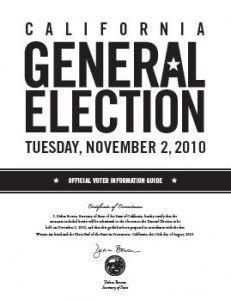Thank
you for taking your civic responsibility seriously. As a registered member of Take Action California, you have taken active steps that play a role in shaping California’s future. There is no doubt that you will not let your voice go unheard in the 2010 General Election.
With four days left to vote, we would like to offer some useful voter information to help you make the best informed decision. Your opinion counts so be sure to cast your ballot soon!
Remember, voting is a RIGHT that comes with privilege. If you have the legal right to vote you are fortunate to participate in making decisions that will impact California’s future. Be Responsible. Be Bold. Exercise Your Choice and VOTE TODAY!
Candidates
Governor
Democratic candidate
Jerry Brown
Republic candidate
Meg Whitman
Senate
Democratic candidate
Barbara Boxer
Republic challenger
Carly Fiorina
Attorney General
Democrat Kamala Harris
Republic Steve Cooley
Treasurer
Democrat incumbent
Bill Lockyer
Republican challenger
Mimi Walters
Lieutenant
Republican incumbent
Abel Maldonado Jr.
Democratic challenger
Gavin Christopher Newsom
Controller
Democratic incumbent
John Chiang
Republican challenger
Tony Strickland
School superintendent
Larry Aceves, no party designation
Democrat Tom Torlakson
Insurance commissioner
Democrat Dave Jones
Republican Mike Villines
Secretary of state
Democratic incumbent
Debra Bowen
Republican challenger
Damon Dunn
Propositions
19 LEGALIZE MARIJUANA UNDER CALIFORNIA BUT NOT FEDERAL LAW. PERMITS LOCAL GOVERNMENTS TO REGULATE AND TAX COMMERCIAL PRODUCTION, DISTRIBUTION, AND SALE OF MARIJUANA. INITIATIVE STATUTE.
SUMMARY
Put on the Ballot by Petition Signatures
Allows people 21 years old or older to possess, cultivate, or transport marijuana for personal use. Fiscal Impact: Depending on federal, state, and local government actions, potential increased tax and fee revenues in the hundreds of millions of dollars annually and potential correctional savings of several tens of millions of dollars annually.
20 REDISTRICTING OF CONGRESSIONAL DISTRICTS. INITIATIVE CONSTITUTIONAL AMENDMENT.
SUMMARY
Put on the Ballot by Petition Signatures
Removes elected representatives from process of establishing congressional districts and transfers that authority to recently-authorized 14-member redistricting commission comprised of Democrats, Republicans, and representatives of neither party. Fiscal Impact: No significant net change in state redistricting costs.
21 ESTABLISH $18 ANNUAL VEHICLE LICENSE SURCHARGE TO HELP FUND STATE PARKS AND WILDLIFE PROGRAMS. GRANTS SURCHARGED VEHICLES FREE ADMISSION TO ALL STATE PARKS. INITIATIVE STATUTE.
SUMMARY
Put on the Ballot by Petition Signatures
Exempts commercial vehicles, trailers and trailer coaches from the surcharge. Fiscal Impact: Annual increase to state revenues of $500 million from surcharge on vehicle registrations. After offsetting some existing funding sources, these revenues would provide at least $250 million more annually for state parks and wildlife conservation.
22 PROHIBIT THE STATE FROM BORROWING OR TAKING FUNDS USED FOR TRANSPORTATION, REDEVELOPMENT, OR LOCAL GOVERNMENT PROJECTS AND SERVICES. INITIATIVE CONSTITUTIONAL AMENDMENT.
Summary
Put on the Ballot by Petition Signatures
Prohibits State, even during severe fiscal hardship, from delaying distribution of tax revenues for these purposes. Fiscal Impact: Decreased state General Fund spending and/or increased state revenues, probably in the range of $1 billion to several billions of dollars annually. Comparable increases in funding for state and local transportation programs and local redevelopment.
23 SUSPENDS IMPLEMENTATION OF AIR POLLUTION CONTROL LAW (AB 32) REQUIRING MAJOR SOURCES OF EMISSIONS TO REPORT AND REDUCE GREENHOUSE GAS EMISSIONS THAT CAUSE GLOBAL WARMING, UNTIL UNEMPLOYMENT DROPS TO 5.5 PERCENT OR LESS FOR FULL YEAR. INITIATIVE STATUTE.
Summary
Put on the Ballot by Petition Signatures
Fiscal Impact: Likely modest net increase in overall economic activity in the state from suspension of greenhouse gases regulatory activity, resulting in a potentially significant net increase in state and local revenues.
24 REPEALS RECENT LEGISLATION THAT WOULD ALLOW BUSINESSES TO LOWER THEIR TAX LIABILITY. INITIATIVE STATUTE.
Summary
Put on the Ballot by Petition Signatures
Fiscal Impact: Increased state revenues of about $1.3 billion each year by 2012–13 from higher taxes paid by some businesses. Smaller increases in 2010–11 and 2011–12.
25 CHANGES LEGISLATIVE VOTE REQUIREMENT TO PASS BUDGET AND BUDGET-RELATED LEGISLATION FROM TWO-THIRDS TO A SIMPLE MAJORITY. RETAINS TWO-THIRDS VOTE REQUIREMENT FOR TAXES. INITIATIVE CONSTITUTIONAL AMENDMENT.
Summary
Put on the Ballot by Petition Signatures
Legislature permanently forfeits daily salary and expenses until budget bill passes. Fiscal Impact: In some years, the contents of the state budget could be changed due to the lower legislative vote requirement in this measure. The extent of changes would depend on the Legislature's future actions.
26 REQUIRES THAT CERTAIN STATE AND LOCAL FEES BE APPROVED BY TWO-THIRDS VOTE. FEES INCLUDE THOSE THAT ADDRESS ADVERSE IMPACTS ON SOCIETY OR THE ENVIRONMENT CAUSED BY THE FEE-PAYER'S BUSINESS. INITIATIVE CONSTITUTIONAL AMENDMENT.
Summary
Put on the Ballot by Petition Signatures
Fiscal Impact: Depending on decisions by governing bodies and voters, decreased state and local government revenues and spending (up to billions of dollars annually). Increased transportation spending and state General Fund costs ($1 billion annually).
27 ELIMINATE STATE COMMISSION ON REDISTRICTING. CONSOLIDATES AUTHORITY FOR REDISTRICTING WITH ELECTED REPRESENTATIVES. INITIATIVE CONSTITUTIONAL AMENDMENT AND STATUTE.
Summary
Put on the Ballot by Petition Signatures
Eliminates 14-member redistricting commission. Consolidates authority for establishing state Assembly, Senate, and Board of Equalization districts with elected representatives who draw congressional districts. Fiscal Impact: Possible reduction of state redistricting costs of around $1 million over the next year. Likely reduction of these costs of a few million dollars once every ten years beginning in 2020.





